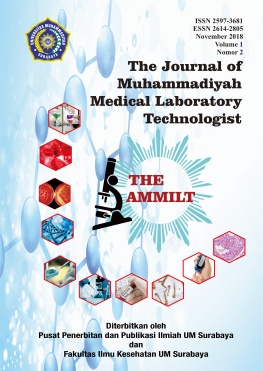Isi Artikel Utama
Abstrak
Proporsi perokok pasif di Indonesia mencapai 40,5 persen dan 78,4 persen perokok pasif banyak terpapar asap rokok di dalam rumah.Setiap hembusan asap rokok mengandung 1015 radikal bebas oksidatif dan nikotinpenyebab leukositosis di dalam darah sebagai bentuk respon inflamasi.Jenis leukosit penunjuk inflamasi akibat asap rokok diawali neutrofilia, neutropenia, limfositosis, limfopenia dan monositosis sebagai bentuk respon inflamasi. Analisis deskriptif dengan rancangan cross sectional digunakan untuk memberikan gambaran respon inflamasi ditinjau dari jumlah leukosit dan jenis leukosit pada perokok pasif yang tinggal di kecamatan Pahandut kota Palangka Raya. Sampel yang diperoleh sebanyak 30 orang diambil dengan teknik Purposive Sampling dimulai dengan observasi, pembagian lembar inform consent, wawancara, pengisian kuesioner, pengambilan sampel darah dan pemeriksaan laboratorium menggunakan hematology analyzer dan apusan darah tepi. Data yang diperoleh dimuat dalam bentuk tabel dan dianalisis dan dideskripsikan dalam bentuk persentase (%). Pada 5 orang (17%) terjadi leukositosis, 2 orang (6%) neutropenia, 1 orang (3%) neutrofilia, 1 orang (3%) limfopenia, dan 6 orang (20%) limfositosis. Leukositosis menunjukkan penanda adanya perubahan imun sistemik, dimana selanjutnya terjadi rekrutmen sel inflamasi diantaranya neutrofil dan limfosit. Radikal bebas dan nikotin memicu inflamasi ditandai dengan neutrofilia dengan limfopenia relatif pada awal inflamasi dan selanjutnya berkembang menjadi limfositosis dengan neutropenia relatif.
Proportion of passive smokers in Indonesia reached 40,5% and 78,4% of them were exposure of cigarette smoke in the house. Each puff of cigarette smoke contains 1015 of oxidative free radicals and nicotine that causes leukocytosis in the blood where it found as an inflammatory response. Either free radicals or nicotine can also cause of neutrophilia, neutropenia, lymphocytosis, lymphopenia, and monocytosis. This study aimed to overview of the inflammatory response in terms of white blood cell count and differential counting of leukocytes in passive smokers (housewives) who live in the district of Pahandut, Palangka Raya. Descriptive analysis with cross sectional design was used in this study. Samples obtained by 30 people were taken with Purposive Sampling technique. Procedure of collecting data starts from observation, distribution of informed consent, interview, answered of questionnaire, blood sampling and laboratory examination using hematology analyzer for measured of white blood cell count and peripheral blood smear for measured of differential counting of leukocytes. The data obtained were analyzed and described in percentage (%). This study found 5 people (17%) of leukocytosis, 2 people (6%) of neutropenia, 1 person (3%) of neutrophilia, 1 person (3%) of lymphopenia, and 6 people (20%) of lymphocytosis. Leukocytosis occurs because of the mechanism of leukocytes recruitment into inflammatory tissues and the types of leukocyte that increased are neutrophils and lymphocytes. Free radicals and nicotine play a major role in triggering inflammation. Acute inflammation cause of exposure of cigarette smoke characterized by neutrophilia and relative lymphopenia in the blood and it will be develop into chronic inflammation that characterized by lymphocytosis and relative neutropenia.
